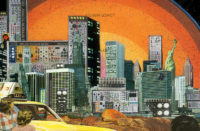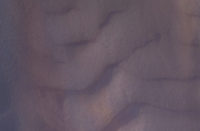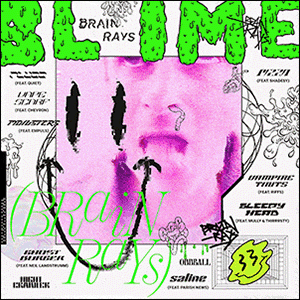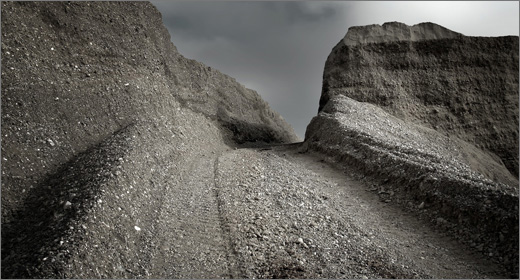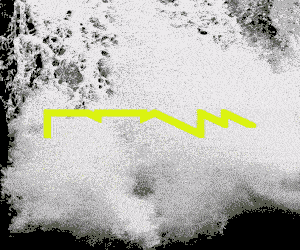In the case of …For The Tired And Ill At Ease… it is the splicing and dicing of approximately one hour of material recorded in a three hour visit to St. Mary’s Church in Thornbury, Melbourne. Heidi Elva played piano (and apparently recognized none of her performance in the final work), as did McCaffrey, as well as taking field recordings of room ambience and various samples from the church organ.

 Scissors and Sellotape is one of several monikers of once UK, now Australian resident John McCaffrey, one-time Clickits member more recently better known for his folk-tinged output as Part Timer and drone-based material as Upward Arrows. This particular name alludes to the working methods used to craft this specific stream of music, a creative process involving heavy cutting, pasting, editing and re-arranging of the source material to arrive at a final product near unrecognizable from its source. In the case of …For The Tired And Ill At Ease… it is the splicing and dicing of approximately one hour of material recorded in a three hour visit to St. Mary’s Church in Thornbury, Melbourne. Heidi Elva played piano (and apparently recognized none of her performance in the final work), as did McCaffrey, as well as taking field recordings of room ambience and various samples from the church organ.
Scissors and Sellotape is one of several monikers of once UK, now Australian resident John McCaffrey, one-time Clickits member more recently better known for his folk-tinged output as Part Timer and drone-based material as Upward Arrows. This particular name alludes to the working methods used to craft this specific stream of music, a creative process involving heavy cutting, pasting, editing and re-arranging of the source material to arrive at a final product near unrecognizable from its source. In the case of …For The Tired And Ill At Ease… it is the splicing and dicing of approximately one hour of material recorded in a three hour visit to St. Mary’s Church in Thornbury, Melbourne. Heidi Elva played piano (and apparently recognized none of her performance in the final work), as did McCaffrey, as well as taking field recordings of room ambience and various samples from the church organ.
A mere glance at the presentation of …For The Tired And Ill At Ease… speaks volumes both of the content and the concept. Though McCaffrey himself is an atheist he nevertheless studied theology at university in an effort to try to understand why people find solace, succour or meaning in religion, and the album is a direct reflection of this fascination. The religious imagery that adorns every last centimetre of the packaging is rendered as haunting, ethereal, almost chilling. Take the ghoulish re-imagining of nuns as ghosts gazing into a black mirror on the front cover, or as hovering, sinisterly smiling figures waiting to prey on the weakness and submission of others. Furthermore, the ellipses at the start and end of the album title are also quite deliberate, as each blunt, secular and sceptical track title is designed as prefix or suffix to that title.
The album runs the veritable gamut of post-production piano processing: delicate vinyl crackle and muffled distortion mute the tinkled ivory in “I Say ‘get used to it’,” McCaffrey’s various field-recordings and samples of the workings of silent organ keys and pedals bedeck the Caretaker-esque looped and muted phrases of “What Can Be Done,” and the familiar sense of place one gets from a Johann Johannsson soundtrack or Dustin O’Halloran meditation pervades some of the albums most poetic moments. The misty-eyed “My Sympathies go out to you,” for example, may begin with the minimalist phrasing of a Ryuichi Sakamoto or Sylvain Chauveau piece, but the palette soon blooms with bass before adding the slightly caustic grittiness and rusted blur that colours “And in the endless pause there came the sound of bees.”
Things also turn decidedly Deaf Center at times, the glacial piano accompanied by tremulous cello on “A simple ‘I know how you feel'” drifting like clouds over sepia mountains and down into darkened valleys a la Pale Ravine, whilst the looped and fading piano, vocal snippets and breathy, crackling ambience of “Healing Touch” could have been an outtake from Neon City. What this essentially boils down to is that, for many people …For The Tired And Ill At Ease… appears to tread myriad but familiar ground. Done well, however, releases such as this don’t have to push the envelope to be both compelling and enduring. McCaffrey may have mined one or two arguably overused post-processing techniques but has not overused them within the album itself, crafting a varied yet cohesive experience. The dying cadences of “Personal Trainers,” so redolent as they are of the best material from Otto Totland and Huw Robert’s Nest collaboration end an album of breathtaking low-level music on an atmospheric and experiential high.
You won’t read another review of …For The Tired And Ill At Ease… anywhere without a mention of the packaging, particularly the first two hundred deluxe edition copies, and with good reason. The 300gsm outer jacket with 5mm spine (yes, that’s particularly wide) housing the 180g slab of pure virgin black vinyl is a wondrous thing to behold all on its own. Also nestling inside the sleeve is a hand-numbered and stamped, twelve-inch square 300gsm art print once again featuring the front cover-image, a double-sided, A3 foldout poster featuring a number of beautiful, and again rather chilling and ethereal images of graveside angel statues, a small credit card sized insert bearing the only release information to be seen anywhere on the physical package, and a download code for a full digital version of the album. A compact-disc edition of the album is also included, housed in a gatefold, letter-pressed sleeve with wraparound band, containing an additional sixteen-page photo booklet featuring ever more imagery, completely different to that on the poster. It isn’t even expensive. What more could a collector possibly wish for?
Fac-ture have curated an almost flawless release in …For The Tired And Ill At Ease… and are clearly a label to keep a very close eye on.
…For The Tired And Ill At Ease… is available on Fac-Ture. Buy at Fac-Ture, iTunes or Amazon.






